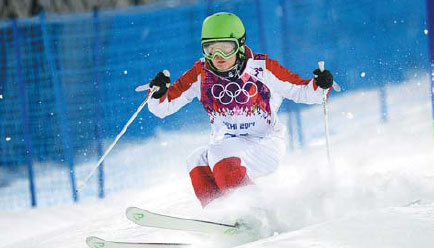Beijing gears up FOR Games
Construction and promotional efforts picking up steam in the capital in 2017
Beijing - When Chinese cross-country skier Man Dandan grabbed the country's first gold medal at the Asian Winter Games in Sapporo, Japan, on Feb 20, winter sports fans nationwide were thrilled.
The prize was regarded as a breakthrough for the Chinese delegation, which used to fair better on the ice rink than on the skiing track.
Before the competition, Man had taken first place in the ladies' sprint final at the FIS China Tour de Ski Changchun stage. A rising star, she began to terminate Nordic countries' and regions' domination in tough games.
Recent Vasaloppet China Festivals, an annual cross-country skiing race launched in Sweden in 1922, also witnessed the rise of young athletes like Man.
"China began to learn how to improve its performance in cross-country skiing events in 2003, several years before Beijing's bid for the 2022 Winter Olympics," said Zhao Xiaolu, deputy director of the Changchun sports bureau.
As we enter the second year since Beijing was awarded the 2022 Winter Olympics, Chinese fans are noticing that many national winter sports teams have been established for the first time, such as the alpine skiing and bobsleigh and skeleton teams.
Chinese athletes also competed in all 64 events at the Sapporo Asian Winter Games, eager to test themselves in as many Olympic winter events as possible.
Getting ready to host
As it prepares to host another edition of the Olympic Games, Beijing's preparation work is so far going smoothly.
Beijing is converting the 2008 Summer Olympic venues into sites for the Winter Games in an effort to control costs.
The LeSports Center - formerly the Wukesong Culture and Sports Center, which hosted the basketball events in 2008 - will host the ice hockey events in 2022. The National Aquatics Center, also known as the Water Cube, will become the curling rink.
According to the Beijing Organizing Committee for the 2022 Olympic and Paralympic Winter Games, competition venues are split into three zones for the 2022 Games. Beijing Zone will host three sports, namely curling, ice hockey and skating, in 12 venues, including eight legacies of the 2008 Summer Games, three newly-built venues and one temporary venue.
President Xi Jinping stressed the need for solid preparation work for the Games when presiding over a symposium in February on the subject, saying that the work should embody the spirit of being green, inclusive, open and clean.
He also vowed zero tolerance in regards to doping and corruption, saying China "should make the Olympic Winter Games as pure and clean as snow and ice".
International Olympic Committee President Thomas Bach said he was sure the Beijing 2022 Olympic Winter Games would be a success.
The remarks were made during Chinese President Xi's historic visit to the IOC headquarters in Lausanne, Switzerland, in January.
"Before we had talks last evening and today, I always said we are very confident about the success of these Winter Games. Now, after his visit, I would say we are sure it will be a success," Bach said.
These remarks can be viewed as a nod of approval to the job done by Chinese organizers over the past 18 months, and also as a motivational spur for preparations in the months and years ahead.
The Beijing 2022 organizing committee, which was set up in December 2015, has assembled a team of nearly 200 staff members across 13 departments and two operational centers.
According to its work plan, the preparatory work will be carried out on schedule in 2017.
Construction of Olympic venues will start this year, including construction of venues for biathlon, cross-country skiing and ski jumping.
"In 2017, Hebei will spare no efforts in the construction of venues and basic infrastructure, and popularization of winter sports in order to lay a solid foundation for a successful Winter Olympics," said Li Pu, a local official from Hebei province.
The Yanqing Zone, which lies between Beijing and the city of Zhangjiakou, is set to stage Alpine skiing, bobsleigh, luge and skeleton disciplines, while the Zhangjiakou Zone will host freestyle skiing, snowboarding, cross-country skiing, Nordic combined, ski jumping and biathlon disciplines.
Construction work will be completed by 2019 so that all of the venues are ready for test events in 2020, organizers said.
"Reusing the 2008 legacy venues really helps Beijing 2022 stay ahead, while verifying Beijing's promise to host the Winter Olympics in a sustainable way," said Gui Lin, head of the Beijing 2022 committee's department of planning, construction and sustainability.
In line with the IOC's Olympic Agenda 2020, the Beijing 2022 Games concept will be incorporated into the long-term development goals for Beijing and neighboring Hebei province.
Construction of new a high-speed railway and freeways connecting Beijing and Zhangjiakou has started, with other related projects set to start soon. The time needed for inter-city travel will be reduced to less than 50 minutes after completion of the projects.
A worldwide competition was launched in August last year to find emblems respectively for the Olympic and Paralympic Winter Games.
A judging panel is assessing the candidate designs and the official emblems are expected to be unveiled in the second half of 2017.
Efforts are being made to expand participation in winter sports in northern China.
The call has triggered greater investment in the winter recreation sector, which has seen more than 100 ski resorts built since Beijing won the 2022 Olympic bid in July 2015.
A high goal
Eyeing a successful tournament at home in 2022, China is also determined to become a winter sports powerhouse in the next decade.
The efforts are two-fold. On the one hand, China is focusing on improving its technical and tactical skills and gaining advantages in individual events.
On the other hand, it aims to popularize winter sports among the general public.
To achieve part of that goal, Changchun, capital of Jilin province, has motivated one million teenagers to enjoy the city's abundant skating rinks and ski resorts during the last Chinese New Year holiday.
The central government also approved a 10-year plan to develop winter sports in November 2016, aiming to expand the scale of the winter sports industry to one trillion yuan ($145 billion).
According to a document released by the municipal government in January, Beijing will have 40 new ice rinks across the city by 2020.
Among them, 16 rinks, including 11 indoor rinks, were built in 2016. Construction of another 10 venues will be completed this year. The rest will be constructed by 2020, the document said.
Public fitness
The Beijing municipal government has mapped out a five-year plan (2016-20) on public fitness, pledging "vigorous efforts" to introduce winter sports to the public including Alpine skiing, speed skating, figure skating and curling.
According to the plan, the government will use sports lottery revenue and other funds to build sporting venues, set up sports associations and organize competitions and festivals.
The General Administration of Sports of China also released a plan in November last year to speed up construction of winter sports infrastructure, aiming to build at least 500 skating rinks before the 2022 Winter Games.
The plan calls for 650 skating gyms, 500 of which will be built in five years, in addition to 800 skiing resorts throughout the country.
Bach predicted that Chinese athletes will be much more competitive in a winter Olympiad on home soil. "We can already see now many improvements in many sports. I am confident the home team in China will be very strong not only in ice sports but also in snow sports. You can already see Chinese athletes coming up ... We know the determination of the Chinese people and the government," said Bach.
xinhua
All-round preparations
The Beijing Organizing Committee for the 2022 Olympic and Paralympic Winter Games pledged to make all-round preparation works to serve the 2022 Olympics. The major venues and facilities will be finished by the end of 2019, serving for the test events in 2020.
This year will also see the launch of some new competition venues including National Speed Skating Oval, National Alpine Ski Center, a national sleigh and National Sliding Center, Nordic Center Ski Jumping Venue, Nordic Center Cross Country Venue and so on. The organizing committee has completed the collection and selection of the emblem.
The emblem has been collected at home and abroad with enthusiastic participation, receiving a total of 4,506 designs from China and all over the world, 2.2 times the Beijing 2008 Olympic Games emblem.
According to the organizing committee, Beijing will host three sports, namely curling, ice hockey and skating, in 12 venues, including eight legacies of the 2008 Summer Games, three newly-built venues, and one temporary venue.
The 2022 Olympic and Paralympic Winter Games is a major event for the country, as well as a milestone in China's history.
As it plays a strong role in the coordinated development of Beijing, Tianjin and Hebei province, it can bring excellent opportunity for development of Beijing.
The working staff in the project will adhere to the principle of energy saving, environmental protection and resource recycling, striving to build up high-quality assets that is beneficial to the public.
For more information of the 2022 Olympic and Paralympic Winter Games, please scan the below code:
|
A student from a primary school in Beijing delivers her design for the emblem on the 2022 Olympic and Paralymic Winter Games at the launch day of the collection and selection for the logo. The organizing committee has received a total of 4,506 designs from China and the world. Provided To China Daily |
|
Ning Qin, 22, becomes the first Chinese to compete in freestyle skiing moguls at the Winter Olympics in Sochi. Franck Fife / Afp |
|
Senior officials from Beijing and the IOC Coordination Commission unlock the marketing campaign of the Winter Games. Zou Hong / China Daily |
(China Daily 05/14/2017 page30)

















